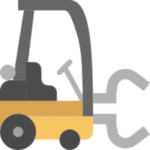Five forklift trip hazards to watch out for
Hazards are all around us. From trailing wires and unattended machinery to slippery floors and obstructed doorways, they’re lurking in all sorts of places, including the unlikeliest.
Some of them can cause minor incidents, such as slips and trips, while others, can result in serious injuries and fatalities. Regardless of your working environment, it’s essential you keep your wits about you at all times, particularly if you work with or around moving vehicles.
As leading manufacturers of forklift forks and attachments, we’re only too aware of the risks forklifts pose to workers on a daily basis. Even when being operated at low speeds, they can cause serious injuries and fatalities.
Mounting, dismounting and moving forklifts comes with its own set of trip hazards. We’ve listed five areas where these hazards tend to happen so you can watch out for them:
HAZARD AREA #1: Forks and attachments
Fitting a fork or an attachment, such as clamp or rotator, to your forklift will instantly change the operating clearances by extending the length and width of the vehicle.
They can also change the capacity of forklifts by making them heavy, which can directly impact the load restrictions. It’s also worth noting that attachments usually alter the stability and centre of gravity. For instance, if an attachment moves the load away from the vertical face of the forks, the maximum load the forklift can carry will be reduced.
HAZARD AREA #2: Steps
It’s easy to fall up or down the steps as you enter and exit forklifts, especially as the size and steepness of them vary, depending on the model.
As simple as it sounds, make sure you’re aware of the height of the steps, that there are no obstructions in the way and you always have one foot on the step, as well as firmly holding on to another part of the forklift (ideally the supporting handles) to keep your balance. And, no matter how much of a rush you might be in, never run up or down them!
HAZARD AREA #3: Pedals
If you’re working with a forklift you’ve never used before, particularly a different model, then make sure you take the time to familiarise yourself with the layout of the pedals before switching the engine on.
When you’ve finished with the vehicle, applying the parking brake will make sure any foot-operated parking brake pedals are out of the way, which is a key safety requirement.
HAZARD AREA #4: Loads
It’s really common for forklifts to topple over. This is generally because they’ve been loaded incorrectly (i.e. overloaded so they’re top-heavy) or you’re just simply trying to cram too much on to them (this can also result in the load falling off too).
Going too fast can cause forklifts to topple over too, particularly if you’re going around a corner or working outdoors on uneven terrain.
HAZARD AREA #5: Surrounding environment
Many forklift hazards are triggered by the conditions in which they’re being operated within. For instance, braking on slippery or uneven floors can cause forklifts to fall over. So too, can operating on dirt and gravel or ramps.
Poor lighting and cluttered surroundings can also make it difficult to see surrounding hazards, as well as create risk-ridden zones.
Forklifts are widely recognised as being up there among some of the most hazardous workplace vehicles, but despite this, the dangers associated with them are often underestimated. By following best practice guidance, like the points shared above, you can watch out for forklift-related hazards rather than being caught out by them.
For more information or to discuss how to minimise the risks posed by your forklift forks and/or attachments, contact us today on 0113 277 1222 or sales@invicta-attachments.co.uk.
Back to all blog posts






